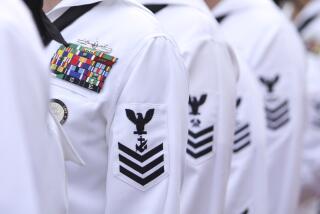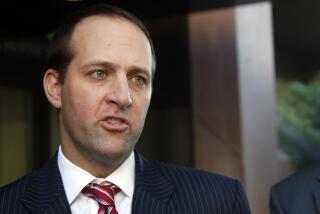Evangelicals Accuse Navy Chaplain Corps of Bias
WASHINGTON — Navy Capt. George W. Linzey, a second-generation evangelical Protestant chaplain, says his father told him long before his career began what he should expect.
“George, there are three chaplain corps: Catholic, high-church Protestant and the rest of us--the low-church Protestants,” said the elder Linzey, describing an informal caste system. “That is the pecking order.”
Three decades later, 46-year-old Linzey--a minister ordained in the Pentecostal Church of God and a 23-year veteran of the Navy chaplain corps--and his fellow evangelicals say they are still treated as second-class citizens.
Most of the high-profile jobs in the chaplain corps go to so-called “high-church” Christians, which include Catholics and mainline liberal Protestant denominations such as Episcopalians, Methodists, Lutherans and Presbyterians.
But the highest percentage of Navy personnel consider themselves evangelical or “low-church” Protestants, such as Baptists and other fundamentalists, who tend to be more conservative in their reading of the Bible.
Linzey and his colleagues say the high-church Christians look down on evangelicals as less formally educated and more working-class. Also, there are historical and doctrinal differences between the two groups, with evangelicals tending to place a higher premium on the individual’s relationship to God.
Long-simmering resentments over alleged “denominational discrimination” spilled forth this summer during Senate consideration of Rear Adm. A. Byron Holderby, a Lutheran minister nominated by President Clinton to be chief of chaplains. After his nomination, Holderby was accused of discrimination by a chaplain from another Lutheran branch. Holderby has since been cleared by the Pentagon inspector general and two weeks ago won Senate confirmation.
The low-church fundamentalists took advantage of the case to speak broadly about their own perceived troubles within the 900-member chaplain corps, which addresses the spiritual needs of the 549,000 men and women in the Navy and Marine Corps.
Officials of the chaplain corps insist there has never been any bias, but evangelical chaplains point to troubling statistics:
* Of the 17 most influential jobs in the chaplain corps, eight are held by members of high-church Protestant denominations, whose members include 15% of Navy personnel, and five by Catholics, who account for 24% of the Navy. The remaining four are held by low-church Protestants, who account for 41% of Navy personnel--by far the largest religious category, according to Pentagon statistics. Most of the remaining 20% list no religious affiliation.
* During the past 30 years, only one low-church Protestant has been chief of chaplains. Six of the last eight have been either Catholic or Lutheran. Lutherans account for about 2% of Navy personnel.
* This fiscal year, five Navy captains have been told to retire: Four are low-church Protestants and one is Catholic. No high-church Protestants have been given a push toward retirement, though each group accounts for a third of the 85 Navy captains in the chaplain corps.
Holderby declined to comment, but several senior officers at chaplain corps headquarters insist that there is no basis for the discrimination complaints.
“I can speak from personal experience. In my 22 years I haven’t been discriminated against,” said Rear Adm. Barry C. Black, deputy chief of chaplains and a Seventh-day Adventist. “I’m as nonliturgical as you can get.”
But Black and two other low-church Protestants on the staff--Capts. Jim Harwood and Charles Carter, both Baptists--haven’t been in top jobs long. They were brought in within the past year.
Evangelicals say few of them ever get into other top posts, such as Naval Academy chaplain, chaplain of the Pacific and Atlantic fleets and director of the Navy chaplain school. Chaplain corps officials counter that those are mostly administrative jobs and that the more important functions are performed by chaplains aboard ship and on Marine bases.
As for the retirements, Navy officials say a board of five admirals--including Black--selected by the Navy Department decided which chaplains should be retired based on their records and age. Among the 35 captains considered for retirement were 11 Catholics, eight high-church Protestants and 16 low-church Protestants.
Linzey and other chaplains say the chaplain corps has ignored their complaints, in part because the evangelical churches lack the organization to apply pressure.
“The leadership of the Navy chaplaincy has long been a religious monopoly, and that chaplaincy is conducted like a spoils system rather than a customer-service organization,” said Ronald G. Wilkins, who served as a Baptist chaplain and retired as a Navy commander in 1995. “The monopoly is always a power bloc of Roman Catholic and various nonevangelical Protestants.”
Black, Holderby’s deputy, said: “I find it difficult to believe that praying clergy are going to conspire to marginalize a whole group of the [religious] community.”
Yet a federal judge found evidence more than a decade ago, when Wilkins was denied promotion to lieutenant commander, that there was a policy at that time to favor Catholics--potentially at the expense of low-church Protestants. As a result, the Navy agreed to scrap two policies: that one of two chaplain corps admirals would always be a Catholic and that Catholics would always make up 40% of the promotion board.
Those practices dated from the late 1970s, when the Navy chaplain corps was headed by Rear Adm. John J. O’Connor.
More to Read
Sign up for Essential California
The most important California stories and recommendations in your inbox every morning.
You may occasionally receive promotional content from the Los Angeles Times.









